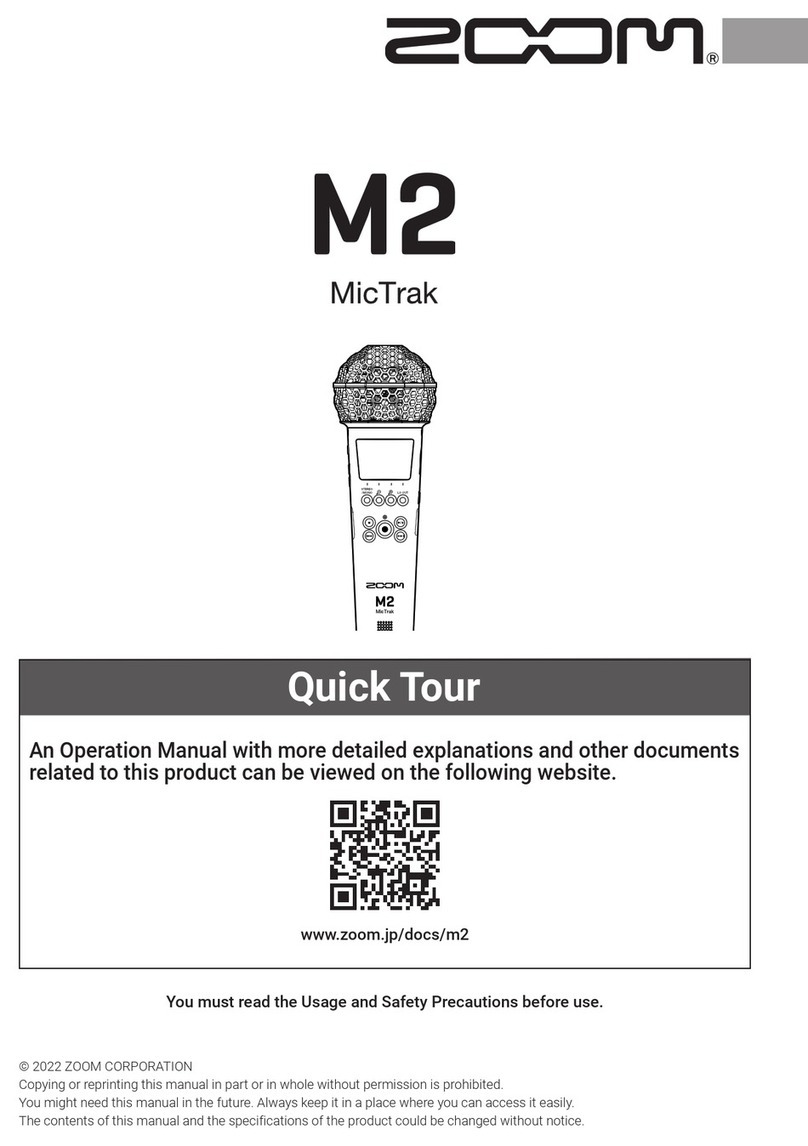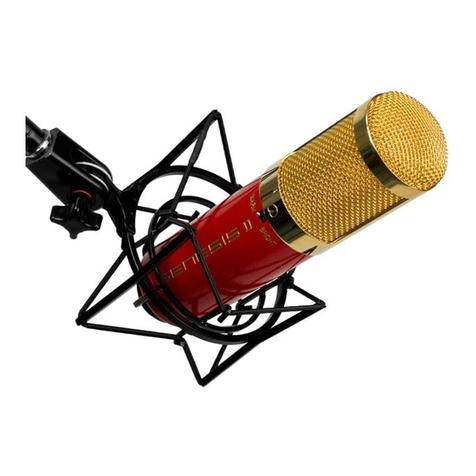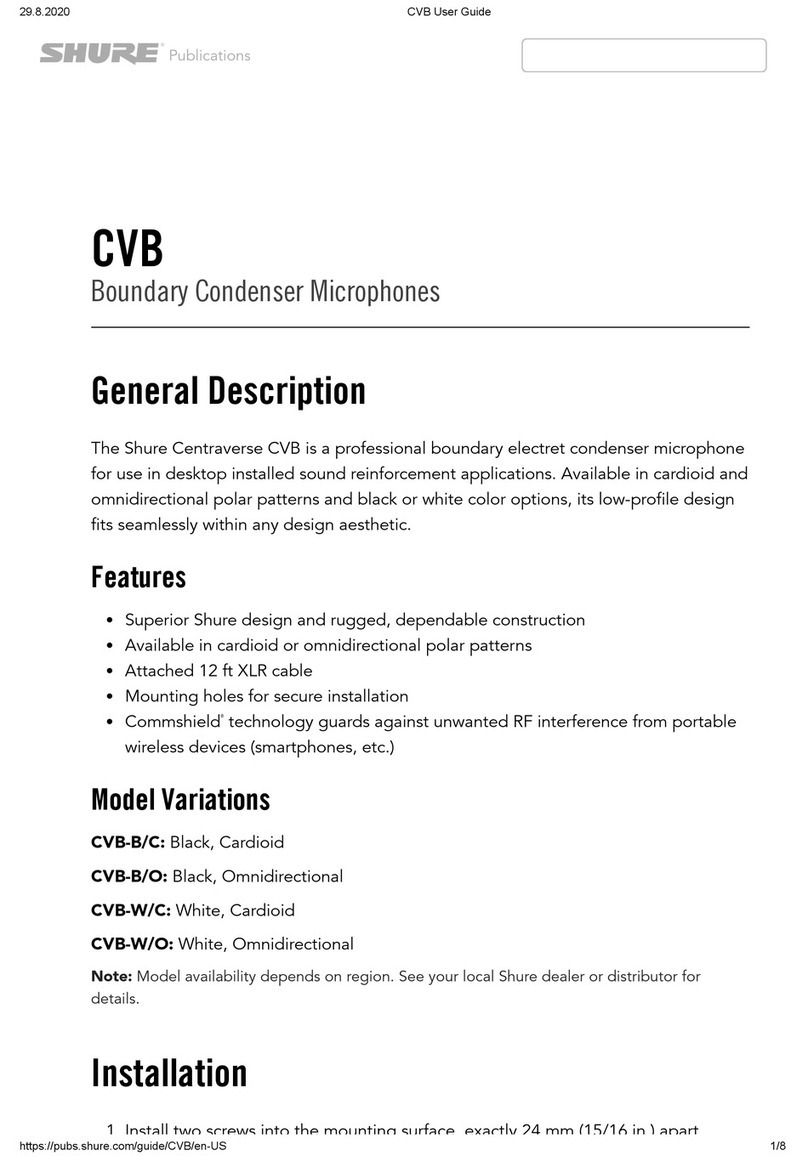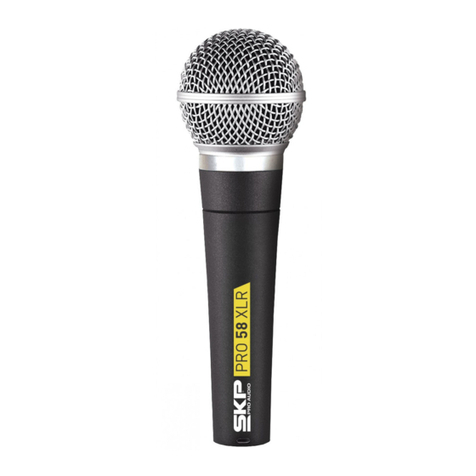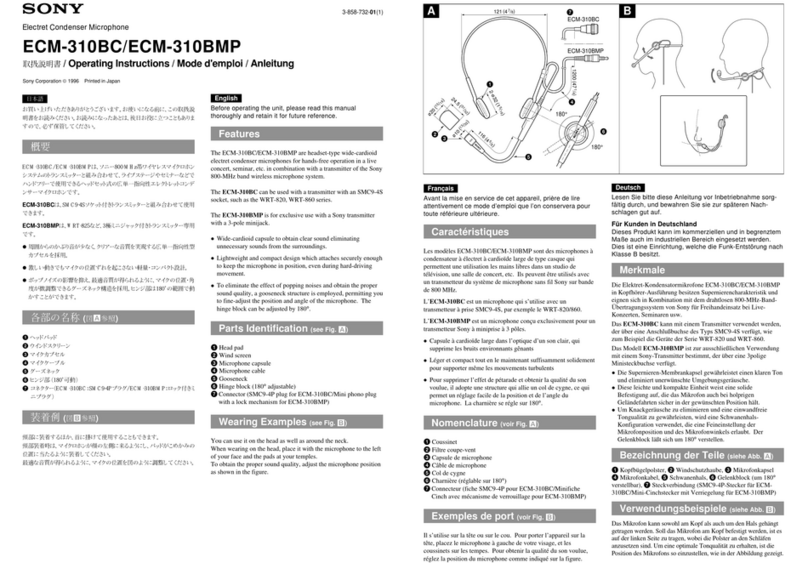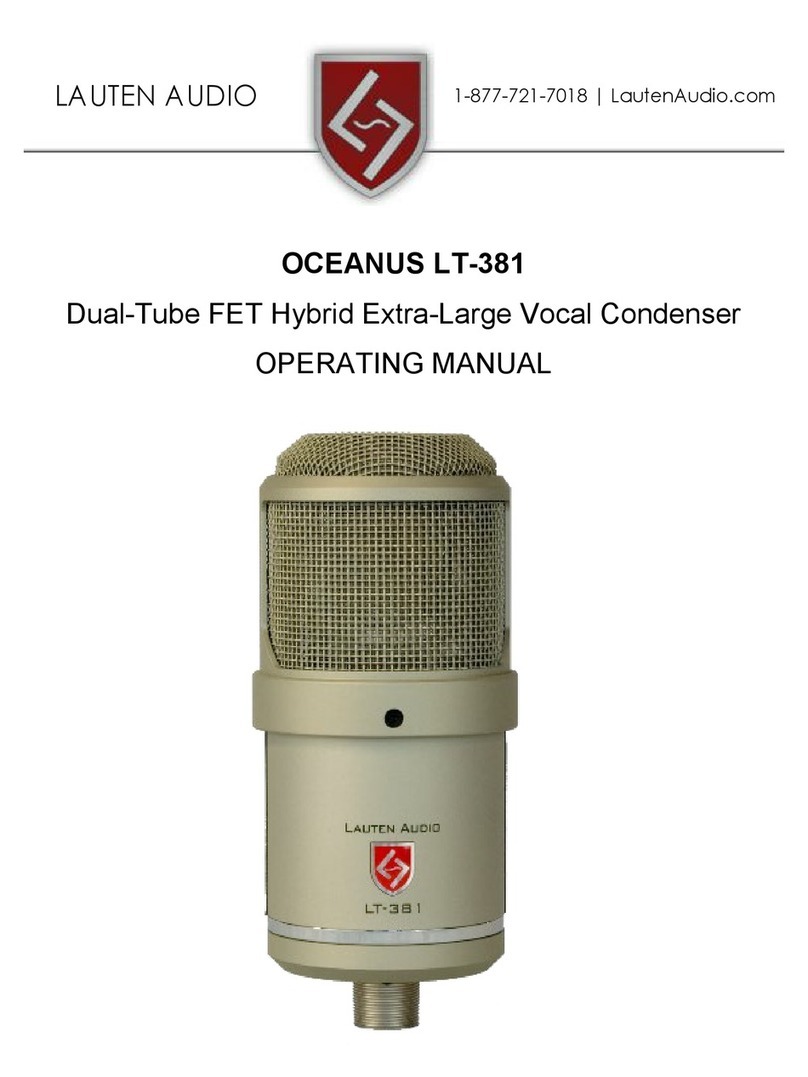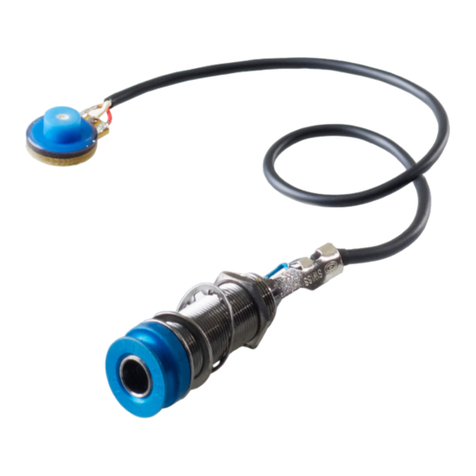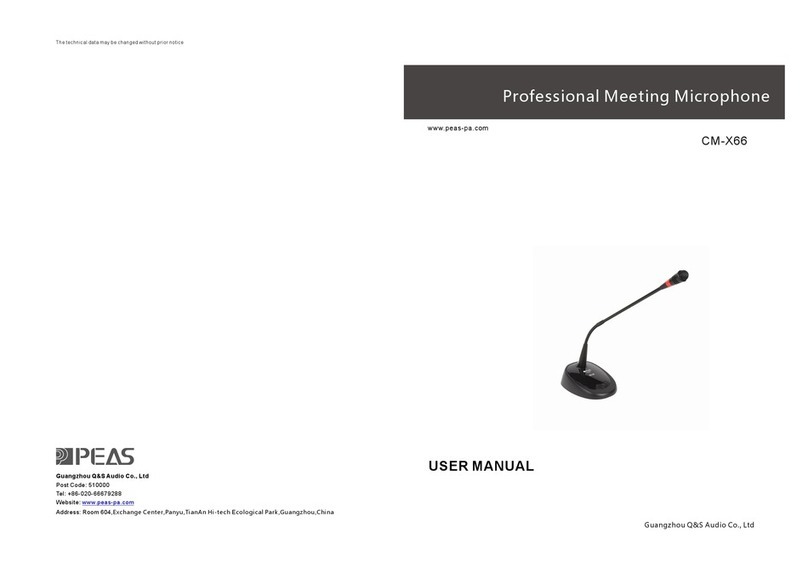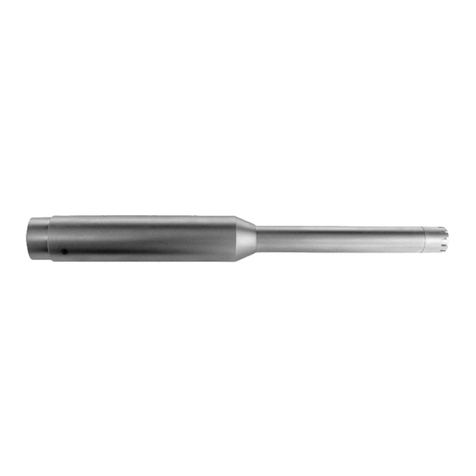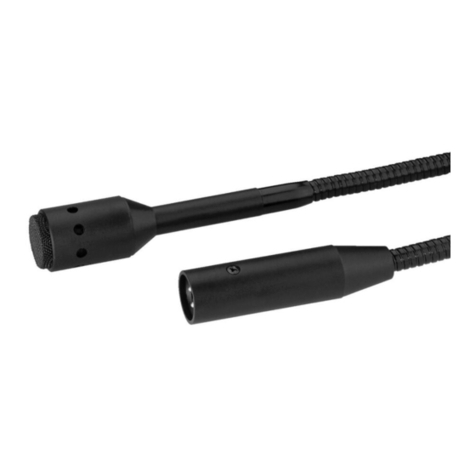Sontronics Apollo 2 User manual

SONTRONICS APOLLO 2
USER GUIDE
Thank you for choosing our APOLLO 2 microphone and welcome to the SONTRONICS family!
We hope you enjoy your new purchase and we invite you to take a moment to
register your mic for our LIFETIME WARRANTY (see below).
We have provided this guide to help you fully understand your microphone and get the best from it.
PLEASE READ THIS GUIDE CAREFULLY before using your APOLLO 2 as it also contains
important information for your safety and for the longevity of your new microphone.
For more information on all our
microphones and accessories,
and about
SONTRONICS
in general,
visit www.sontronics.com
&
M
A
D
E
I
N
T
E
U
K
D
E
S
I
G
N
E
D
,
D
E
V
E
L
O
P
E
D

ABOUT YOUR APOLLO 2
Our British-made and designed SONTRONICS APOLLO 2 is based on our
groundbreaking APOLLO, which has become a must-have for studios,
composers, venues and sound stages all over the world.
The APOLLO 2 utilises two ribbon motors set in X-Y Blumlein formation
(named after English electronics engineer Alan Blumlein who invented
stereo recording techniques in the 1930s) in addition to a British-made
circuitboard of our proprietary design and a custom-wound transformer
made here in SONTRONICS’ hometown of Poole.
The delicate ribbons combined with the APOLLO 2’s high sensitivity,
super-low self-noise and the unique design of the seamless, laser-
welded British stainless steel grille allow the mic to soak up every detail
of whatever is being recorded, capturing a truly stunning and superbly
accurate three-dimensional image.
APOLLO 2 is ideal for use as an overhead room microphone and gives
sublime results on orchestra, choir and chamber ensembles, grand
and upright piano in studios or in live environments. It gives natural,
expansive results with perfect detail and clarity in the high frequencies
and a balanced depth and fullness to the mids and lows.
APOLLO 2 is also perfect for using as an overhead microphone for
drums and percussion or smaller instrument and vocal ensembles,
and it can be used to great eect as a room or ambient mic, whether
you’re recording in a church, an opera house, on a live stage or in a
home studio set-up. You can also use APOLLO 2 as a mono ribbon
microphone by isolating one ribbon motor (using just one XLR cable)
and turning the mic so that the live ribbon is facing the source.
Supplied with its shockmount and Y-cable in a sturdy flightcase,
APOLLO 2 is an absolutely stunning addition to any mic collection.
APOLLO 2 KEY FEATURES
• Phantom-powered stereo ribbon mic
• Two ribbons in X-Y Blumlein formation
• Made in the UK
• Incredibly open, natural sound
• Captures every intricate detail
• Rich mid & low frequencies
• Covered by Lifetime Warranty
• Ideal for piano, orchestral, choral,
chamber or opera recordings, in studio or
live environments
TECHNICAL SPECIFICATIONS
Polar pattern: Figure-of-eight x2
Frequency response: 20Hz - 15kHz
Sensitivity: 18mV/Pa -33dB ±1.5dB
(0dB = 1V/Pa @ 1,000Hz)
Impedance: ≤150 Ohms
Equivalent noise level: 10dB (A-weighted)
Max SPL (for 0.5% THD @ 1kHz): 125dB
Power: Phantom power 48V required (x2)
Connector: 6-pin to two 3-pin Neutrik®
XLR-M connectors (cable supplied)
Dimensions: 260 x 65 x 65mm
Weight: 2020g (2605g with shockmount)
Comes with: shockmount, flightcase,
6-pin to two 3-pin XLR-M cable
APOLLO 2 QUICK START GUIDE
• Attach the supplied shockmount on to a microphone stand.
Make sure you are using a sturdy stand with a weighted boom
arm in order to support the weight of the APOLLO 2 safely.
• Sit APOLLO 2 in the shockmount and secure firmly in place
by turning the threaded ring at the base of the mount (not by
turning the microphone).
• Position APOLLO 2 at the ideal distance and angle from the
source(s) being recorded (see opposite for Placement Advice).
• Connect the six-pin end of the supplied Y-cable to the base of
APOLLO 2, and then connect two XLR cables to the two three-pin
connectors at the end of the Y-cable.
• Ensure that all input, output and EQ levels on your input device
(eg, mixer, interface, soundcard) are set to ZERO and phantom
power is switched OFF before connecting the male ends of the
two XLR cables to two ‘Mic In’ sockets on your device.
• Connect your input device to your computer and make
sure it is communicating with your DAW program, ensuring
that all up-to-date drivers have been downloaded.
• Turn on phantom power and adjust the levels as required
and you are now ready to go!
Plug the XLR cables into two
Mic Input sockets on your device and
then turn on 48V phantom power
Secure APOLLO 2
in its shockmount
and then set
in position
Use two XLR
cables to connect
APOLLO 2 to
your input device
(first ensuring
that levels are
set to zero and
power is o)
Tighten the mic in
place by using this
threaded ring
Input device,
eg: interface, soundcard, mixer

HOW YOUR APOLLO 2 WORKS
SONTRONICS ribbon microphones feature an
extremely thin strip of corrugated aluminium
suspended between two powerful magnets. When
sound pressure reaches the ribbon, its subsequent
movement within the magnetic field induces an
electrical current. This signal passes through a
custom-wound transformer and is then further
amplified by the internal preamp circuit.
The polar pattern of a ribbon microphone is naturally
figure-of-eight; the ribbon only picks up signal from
the front and rear and nothing at all from the sides.
Our ribbon mics (including SIGMA 2 & DELTA 2)
give a very intimate reproduction of sung vocals or
instruments, and are perfect for use in spaced stereo
recording applications where rejection of sound from
the o-axis positions is critical. A figure-of-eight mic
can also be used in combination with a cardioid mic
for mid-side stereo technique.
Ribbon mics have a very specific frequency
response, reproducing less high-frequency output
and capturing few ambient frequencies (‘less air’),
which leads to an authentic, natural-sounding result.
Traditional ribbon mics were renowned for having
extremely low sensitivity and required lots of gain to
boost the signal in the mix, sometimes resulting in
unwanted distortion and noise. However, SONTRONICS
ribbon mics include a 48V-powered preamplified
circuit, resulting in much higher sensitivity and making
them more versatile and much easier to use than
traditional, unpowered predecessors.
SONTRONICS’new ribbon mics –SIGMA 2, DELTA 2
and APOLLO 2 – also uniquely feature RFI (radio
frequency interference) filters in their circuits, which
greatly reduce the possibility of the microphone
picking up radio signals, making them even more
suitable for using in a live or stage environment.
USING YOUR APOLLO 2
• Front & back: Each of APOLLO 2’s ribbon motors has a figure-of-eight pickup pattern and, as is usual for all
ribbon mics, you will notice slightly dierent tonal characteristics when recording from the front or from the
rear. This is quite normal and can actually be very useful.
• Stereo recording techniques: APOLLO 2 can be used for various recording techniques, most obviously for
overhead and room recording where you might otherwise use a condenser microphone with an omni pattern,
the dierence being that APOLLO 2 gently limits the high-frequency response and delivers a more natural,
intimate reproduction.
• Instrument miking: APOLLO 2 can also be used for closer-miking of instruments positioned either in its
normal X-Y position (the front of the mic, with the logo, facing the source) or in mid-side position, where the
mic is turned 45° so that one of the ribbons is facing the source and the other is facing left to right.
• Mono recording: You can use APOLLO 2 as a mono ribbon microphone by isolating one of the ribbon motors,
by connecting just one XLR cable to either the UPPER or LOWER connector on the supplied Y-cable.
• Frequency response: Ribbon microphones do not have an accentuated high-frequency response and this
can result in a very intimate recording when using on instruments.
• Suggested use: APOLLO 2 gives beautiful results as an overhead mic (either on its own or in a multiple-mic
arrangement), on orchestra, choir, instrument ensembles, church organ and drumkit. It also gives beautiful
results on grand or upright piano, harp, acoustic guitar, guitar amps, vocals, solo instruments (in stereo or
mono), and as a room or ambient mic in addition to any other multiple mic set-up.
PLACEMENT ADVICE
NB: Take care not to place APOLLO 2 too close to any loud source as the delicate ribbon elements can be
overloaded or damaged by high pressure levels. NEVER BLOW DIRECTLY INTO APOLLO 2!
APOLLO 2’s high sensitivity and open grille design allows it to be placed up to five or ten metres (15 to 32 feet)
or more away from the instrument(s) being recorded and yet it will still capture all the detail of the instruments
or voices as well as all the ambience of the space you are recording in. This makes APOLLO 2 perfect for
capturing the natural acoustics of any room, from a cathedral to a home studio.
When recording grand piano, we would advise that the lid is propped open securely at its fullest position and
for APOLLO 2 to be positioned just inside the lid, about halfway down the soundboard. The mic should be at
45° from upright, pointing towards the piano. You can also experiment with moving the microphone closer into
the soundboard right under the lid for an even more detailed and intimate sound.
If using the APOLLO 2 in mono mode for solo instruments or vocals, turn the mic 45° so that the ribbon you are
using is facing the source. When recording vocals or wind instruments, use a pop filter such as the SONTRONICS
ST-POP to protect the mic from air blast and moisture and to reduce plosives and sibilance.

IMPORTANT CARE & SAFETY INFORMATION
As with all sensitive electrical equipment, your APOLLO 2 microphone
should be treated with care and respect at all times. Here are a few tips
to help extend the life of your mic and keep it working at its best…
• When you’re not using your microphone, always keep it in its protective flightcase.
• Keep your microphone away from moisture, liquid, naked flame, direct heat or
powerful light sources, and take care to avoid any knocks or bumps. Do not
place hot or cold drinks near your microphone, in case of spillage or heat transfer.
• Avoid transferring the microphone from cold to warm environments as this can lead to condensation forming
inside, which will adversely aect its performance. Should condensation occur, leave the microphone to reach
room temperature before using it again.
• When recording vocals, ALWAYS use a popshield to help prolong the life of the ribbon element.
• Do not turn on phantom power before the mic is plugged in as this can lead to damage to the sensitive
components inside the microphone. Similarly, when you’ve finished using your mic, turn o the phantom
power BEFORE disconnecting the mic.
• Use a soft cloth to clean your microphone after use (especially when recording vocals or wind instruments).
Do not use any solvents, thinners, chemical cleaners or aerosols as they could cause damage to the mic body.
• Due to its mechanical nature, the ribbon element will naturally stretch over time (and the ribbon motor itself is not
covered by our warranty). If you notice the sound of your microphone becoming distorted or duller than usual,
contact us to arrange for a non-warranty ribbon replacement.
• If subjected to sudden impact or a sudden loud sound source, the ribbon may break or disintegrate completely,
resulting in no signal at all. Please contact us to arrange for a new ribbon to be fitted.
• Under no circumstances should you attempt to open or service the microphone yourself. There are no
user-serviceable parts to the microphone and it will invalidate your warranty and may result in danger to you
and to the mic. Contact us or your local stockist or distributor for advice and help if you need it.
• If your mic exhibits any unusual behaviour, noise, smell or smoke, STOP USING IT IMMEDIATELY, disconnect
it from any other device and contact us or your local stockist/distributor for advice as soon as possible.
CONTACT US: info@sontronics.com • www.sontronics.com
All our microphones are designed and developed
here in the UK by SONTRONICS’ founder and designer
Trevor Coley. We spend a long time creating and
crafting our microphones with extreme care and
attention, and all our new models are beta-tested with
top artists, musicians and producers (including the
engineers at Abbey Road Studios) before they
go into production.
Each circuitboard is constructed using the highest
quality components to ensure that your microphone
delivers you many years of worry-free use.
The capsules in our condenser microphones are
diligently hand-made using gold-sputtered Mylar
film which is no more than 6 microns thick (seven
times thinner than a human hair) and then artificially
pre-aged to ensure stability and to also give each
microphone its specific characteristics
Our ribbon microphones employ a microscopically
thin strip of corrugated aluminium ribbon and the
most powerful rare-earth magnets to achieve class-
leading sensitivity and audio reproduction. They are
built with British-made circuitboards, CNC-engineered
metal parts and precision-moulded grilles made from
British stainless steel mesh. The APOLLO 2 stereo
ribbon mic uses a top-quality Mogami® cable with
premium Neutrik® connectors.
SONTRONICS valve microphones (ARIA & MERCURY)
also employ UK-made circuitboards and utilise
hand-selected, European-made (or vintage British-
made), dual-triode vacuum tubes chosen for their
consistency in delivering a balanced frequency
response without over-colouring the original signal.
Our ribbon, dynamic and valve microphones are
hand-built in our UK headquarters, where our
experienced engineers put all of our mics through
several levels of quality control tests using specialist
laboratory equipment to ensure they meet (and
surpass) a series of strict performance targets.
In-depth audio tests are also carried out to ensure
each mic is working perfectly.
You can be sure that your microphone has been
lovingly crafted, expertly put through its paces,
stringently tested and hand-packaged so that you
can simply plug it in and start making professional-
quality recordings straight out of the box. We hope
you enjoy your microphone!
ABOUT OUR MICS
Other Sontronics Microphone manuals
Popular Microphone manuals by other brands
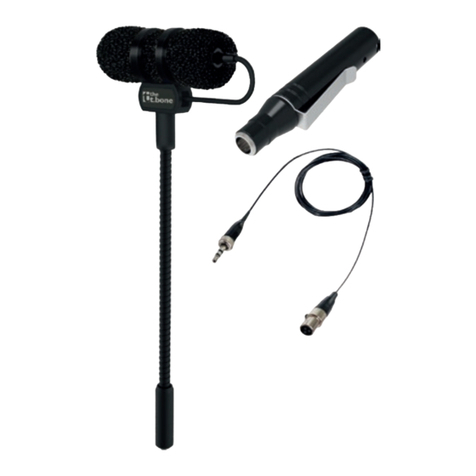
the t.bone
the t.bone Lucan System CC 200 RC quick start guide

SkyAzúl
SkyAzúl MicroGuard 534 Operator's manual
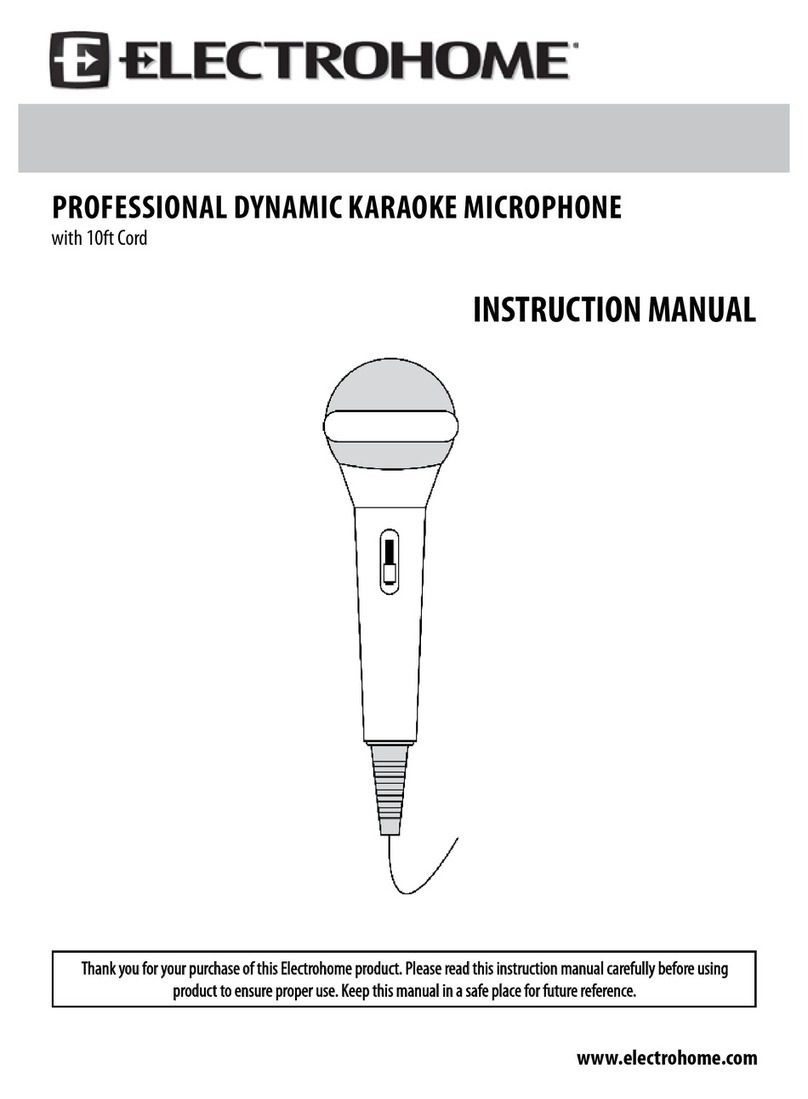
Electrohome
Electrohome Professional Dynamic Karaoke Microphone instruction manual
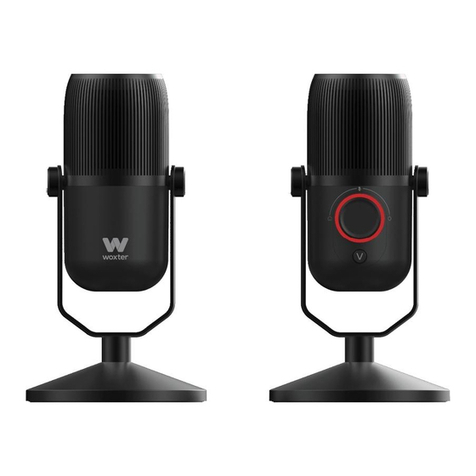
WOXTER
WOXTER Mic Studio 100 Pro user guide
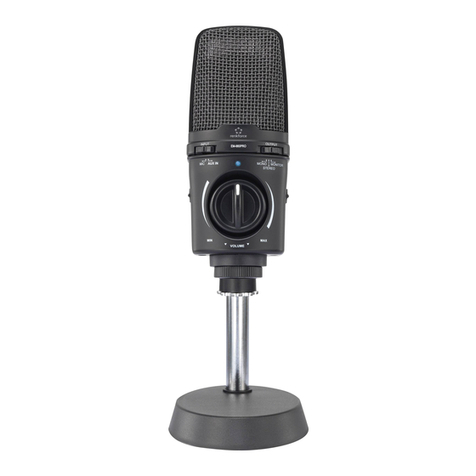
Renkforce
Renkforce 1359968 operating instructions
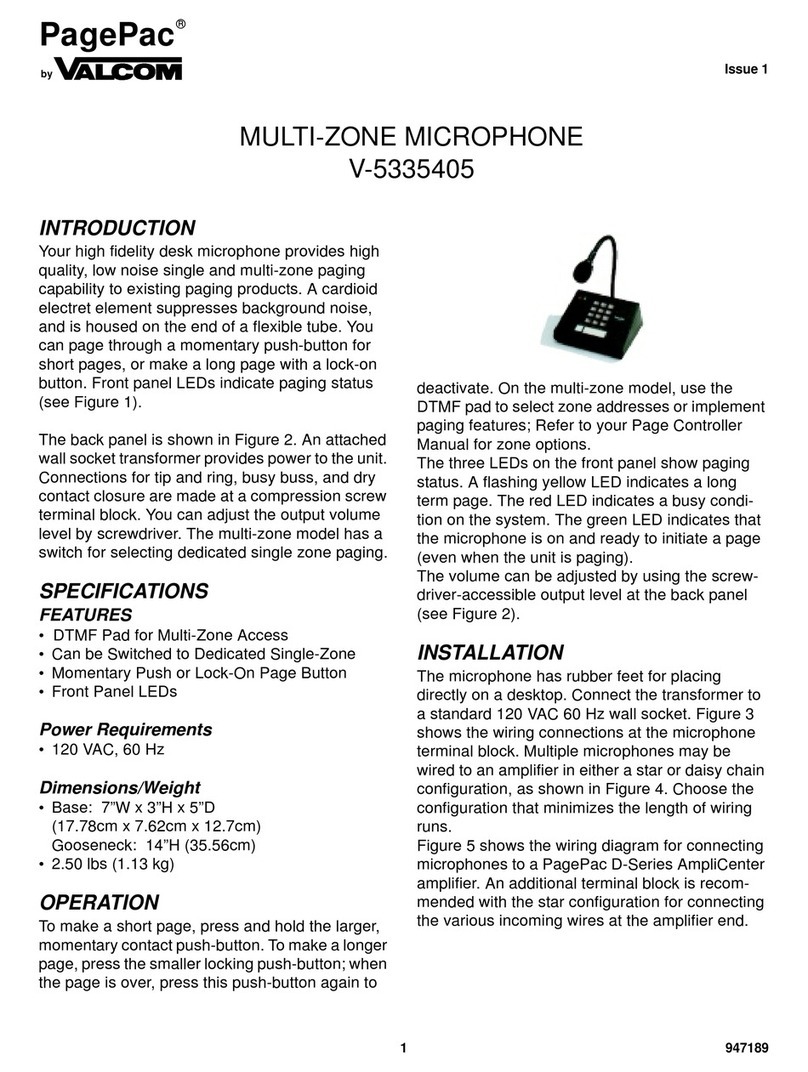
Valcom
Valcom V-5335405 specification

